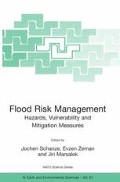Abstract
Floods and other seemingly weather related natural disasters have been increasing not only by reported damage but also by frequency and intensity (www.munichre.com). As global climate models predict a clear increase in temperature and weather extremes (IPCC 2001) due to increase in the atmospheric concentration of green house gases (GHG) it is obvious to relate the reported increase in flood risk to climate change. However, extreme precipitation is neither correctly modelled in existing global models nor correctly covered in existing statistical analysis of the past due to its inherent variability in space and time. This is specially true for the data base of future risk analysis as along with the spatial extend of typical flood prone catchments the need for regional and local estimates of extreme precipitation is increasingly important. New methods as well as new combinations of existing methods are required to address climate change related flood risk on the regional level.
Access this chapter
Tax calculation will be finalised at checkout
Purchases are for personal use only
Preview
Unable to display preview. Download preview PDF.
References
Bernhofer Ch. and Goldberg V. (2001) CLISAX – Statistische Untersuchungen regionaler Klimatrends in Sachsen. Final Report of the Saxon State Office for Environment and Geology, Dresden.
Bernhofer Ch., Goldberg V. and Franke J. (2002) CLISAX II – Assimilation von standardisierten und abgeleiteten Klimadaten für die Region Sachsen und Ausbau der Sächsischen Klimadatenbank. Final Report of the Saxon State Office for Environment and Geology, Dresden.
Blümel K., Klämt A., Malitz G., Matthäus H., Rachner M. and Richter D. (2001) Hydrometeorologische Untersuchungen zum Problem der Klimaveränderungen. Ber. Dt. Wetterdienst 219, Offenbach.
Chmielewski F.M. (2003) KLIVEG – Mögliche Auswirkungen klimatischer Veränderungen auf die Vegetationsentwicklung in Sachsen. Final Report of the Saxon State Office for Environment and Geology, Dresden.
Conway D. and Jones P.D. (1998) The use of weather types and air flow indices for GCM downscaling. J. Hydrol. 212/213, 348–361.
Egger J. (1995) Regional statistical-dynamical climate modelling tests. Contr. Phys. Atmos. 68: 281–289.
Enders G. (1999) Klimaänderungen in Bayern und ihre Auswirkungen. Final Report, Bayerischer Klimaforschungsverbund (BayForKlim), Ludwig Maximilian University, Munich.
Enke W. and Spekat A. (1997) Downscaling climate model outputs into local and regional weather elements by classification and regression. Climate Research 8, 195–207.
Enke W., Deutschländer T. and Schneider F. (2005) Results of 5 regional climate studies applying a weather pattern based downscaling method to ECHAM4 climate simulations. Met. Z. (in press).
Flemming G. (2001) Angewandte Klimatologie von Sachsen. Basis- und Zustandsklima im Überblick. Tharandter Klimaprotokolle 4, Dresden University of Technology.
Franke J., Goldberg V., Eichelmann U., Freydank E. and Bernhofer Ch. (2004) Statistical analysis of regional climate trends in Saxony. Climate Research 27 (2), 145–150.
Fuentes U. and Heimann D. (1996) Verification of statistical dynamical downscaling in the Alpine region. Climate Research 7, 151–168.
Herzog J. and Müller-Westermeier G. (1998) Homogenitätsprüfung und Homogenisierung klimatologischer Messreihen im Deutschen Wetterdienst. Ber. Dt. Wetterdienst 202, Offenbach.
HMU-MD (1973) Klima und Witterung im Erzgebirge. Hydrometeorologick’y Ústav CSSR, Meteorologischer Dienst der DDR (eds) Abh. Meteorol. Dienst DDR 104, Berlin.
IPCC (2001) Third Assessment Report of Working Group I of the IPCC. Summary for Policymakers. Shanghai.
Mann M.E., Bradley R.S. and Hughes M.K. (1999) Northern Hemisphere Temperatures During the Past Millennium: Inferences, Uncertainties, and Limitations. Geophysical Research Letters 26 (6): 759–762.
Owen S.J. (1992) An implementation of natural neighbour interpolation in three dimensions. MS thesis, Brigham Young University, Provo, UT.
Parlow E. (1994) Faktoren und Modelle für das Klima am Oberrhein – Ansätze und Ergebnisse des Regio-Klima-Projektes REKLIP. Geogr. Rundsch. 3, 160–167.
Rapp J. (2000) Konzeption, Problematik und Ergebnisse klimatologischer Trendanalysen für Europa und Deutschland. Ber. Dt. Wetterdienst 212, Offenbach.
Rapp J. and Schönwiese CD (1995) Klimatrend-Atlas Deutschland 1891–1990. Frankfurt Geowiss. Arb. 5, University of Frankfurt (Main).
Schnur R. and Lettenmaier D.P. (1998) A case study of statistical downscaling in Australia using weather classification by recursive partitioning. J. Hydrol. 212/213, 362–379.
Schönwiese C.D. (1995) Klimaänderungen. Daten, Analysen, Prognosen. Springer, Berlin.
Schönwiese C.D. and Malcher J. (1985) Nicht Stationarität oder Inhomogenität? Analyse klimatologischer Zeitreihen. Wetter Leben (Vienna) 37, 181–193.
Schrödter H. (1985) Verdunstung – Anwendungsorientierte Messverfahren und Bestimmungsmethoden. Springer, Berlin.
Schwanecke W. and Koch D. (1970) Mittelgebirge und Hügelland der DDR. Klimastufen, zusammengestellt nach Ergebnissen der forstlichen Standorterkundung von 1956– 1970. Akad. Landwirt. Wiss. DDR, Potsdam.
Werner P.C. Gerstengarbe F.W. and Oesterle H. (2001) Klimatypänderungen in Deutschland im 20. Jahrhundert. Climate status report 2001, Deutscher Wetterdienst, Offenbach.
Author information
Authors and Affiliations
Editor information
Editors and Affiliations
Rights and permissions
Copyright information
© 2006 Springer
About this paper
Cite this paper
BERNHOFER, C., FRANKE, J., GOLDBERG, V., SEEGERT, J., KÜCHLER, W. (2006). REGIONAL CLIMATE CHANGE: To be included in Future Flood Risk Analysis?. In: Schanze, J., Zeman, E., Marsalek, J. (eds) Flood Risk Management: Hazards, Vulnerability and Mitigation Measures. NATO Science Series, vol 67. Springer, Dordrecht. https://doi.org/10.1007/978-1-4020-4598-1_8
Download citation
DOI: https://doi.org/10.1007/978-1-4020-4598-1_8
Publisher Name: Springer, Dordrecht
Print ISBN: 978-1-4020-4596-7
Online ISBN: 978-1-4020-4598-1
eBook Packages: Earth and Environmental ScienceEarth and Environmental Science (R0)

